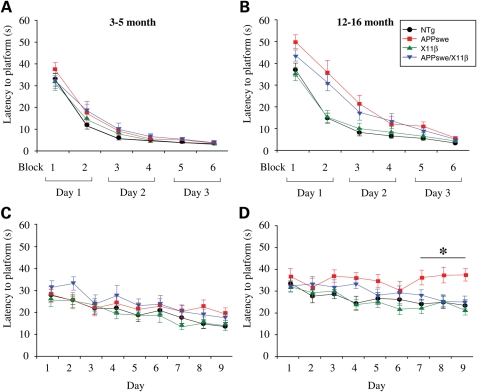Figure 3.
X11β improves acquisition of water maze platform location in 12–16 months APPswe mice. Escape latencies in seconds (s) for NTg, APPswe, X11β and APPswe/X11β mice were measured during visible and hidden platform training in the Morris water maze test. (A) And (B) shows escape latencies to the visible platform in 3–5 months (A) and 12–16 months (B) mice. No significant differences were detected between any of the genotypes in visible platform training at 3–5 months of age (two-way ANOVA). In 12–16 months animals both APPswe and APPswe/X11β transgenics showed increased latencies in the first three blocks (day 1 and first block of day 2) of visible training compared with both X11β and NTg (P < 0.05); however, no differences were detected between NTg and X11β and between APPswe and APPswe/X11β at any time point (two-way Anova with LSD post hoc test). (C) And (D) shows escape latencies to the hidden platform in 3–5 months (C) and 12–16 months (D) mice. No significant differences were detected between any genotype in 3–5 months mice (two-way ANOVA) and all genotypes showed significant improvement in escape latencies over the testing period (both days 1 and 2 versus days 5–9, P < 0.05; two-way ANOVA with LSD post hoc test). Twelve to 16 months NTg, X11β and APPswe/X11β likewise showed significant improvement in escape latencies over the testing period (day 1 versus days 7, 8 and 9, P < 0.05; two-way ANOVA with LSD post hoc test). However, in 12–16 months mice, latencies were specifically increased in APPswe compared with all other genotypes on days 7, 8 and 9 of testing and this effect was rescued in APPswe/X11β mice (two-way ANOVA with LSD post hoc test; P < 0.01 day 7; P < 0.001 days 8 and 9). In addition, APPswe (but not APPswe/X11β) mice showed a significant increase in escape latency compared NTg and X11β mice on day 4 (P < 0.01 two-way ANOVA). * Indicates significant differences between APPswe and all other genotypes. n = 12–20 for 3–5 months mice; n = 17–21 for 12–16 months mice. Error bars are ± SEM.

